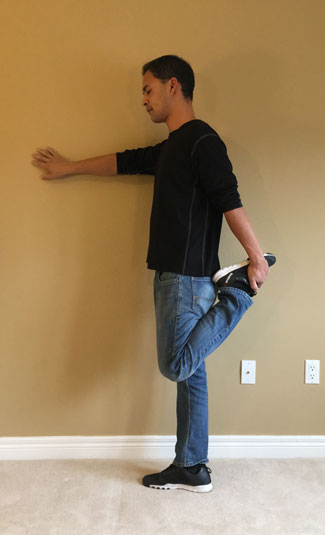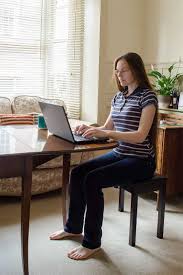5 Tips & exercises to help your back pain while at work. #2: Stand
Sherwin Nicholson | Updated Dec 4, 2020
Continued from Tip & exercise #1: Perform
Although sitting like a Pianist is crucial for retraining and reconditioning your back, it’s only part of the 5 actions taught.
As you are just getting used to the new posture, you’re bound to get tired from practicing it.
Also, if you do rely on using the backrest or a lumbar support more than you should, it is always a good idea to stand frequently.

Stretch your quads while you’re at it
What is so important about standing to help my back?
COVID-19 lockdowns have everyone sitting much more often than we would like to. This is no reason to allow your back to fall prey to the dangers of sitting for even longer now! Get up more. Don’t just sit because you feel you are in different circumstances!
Because you are sore from sitting, your body needs to change position in order so you can keep all of the muscles of your lower body active. Sitting really shuts off this much needed aspect by deactivating your leg, back and hip muscles.
The benefits of standing
- Re-aligns your pelvic tilt (good for the discs)
- Helps you straighten up your spine again (keeps the vertebrae balanced)
- Stretches your hip flexor muscles (less tension on lumbar spine)
- Stimulates the glute/butt muscles (less strain)
- Brings needed circulation down through the legs (to both the muscles and nerves)
- Stimulates virtually every muscle in your body
It won’t interrupt your day
You only need to stand briefly for a few seconds. Think of it as practicing one rep of doing a squat. Your legs need it and your back will feel better.
There are many things you can find to do in the office or at your desk that can involve that very brief standing action.
Here are some quick suggestions to get you started:
- Don’t roll your chair to move to your items, instead choose to stand and walk to them
- Don’t lean over and reach while seated in your chair, stand closer
- Put your coffee/tea/water further away so you must stand to have it
- Stand at least every 10 minutes and just for a few seconds to keep your leg muscles active
Once you are able to get into this habit, you’ll have less pain. As a result, you’ll find it easier to sit more often and with less pain. But don’t let yourself fall into the bad habit of sitting for even longer. You’ll only end up frustrated if you get sore again.
Each time that you stand, you are practicing an exercise. You are doing one half squat. This is important for your gluteus muscles as they are the key to relieving your pain.
A very helpful tip is to stand without using your hands and arms to assist you. Make your legs do all of the work. They need it. This is both for raising AND lowering.
For every time that you stand
- Straighten your spine before you get up
- Stand without using your arms and hands to raise yourself up
- Keep your feet shoulder width apart
- Get up slowly and lower yourself slowly
- Tighten your abdominal/stomach muscles when you raise and lower
- Squeeze your butt/glute & calf muscles firmly when you raise and lower
This all seems like a lot to keep track of so just focus on a few at a time.
After a short time, you’ll be able to do it all without thinking about it.
You can now use a very small part of your time at work as a practical opportunity to relieve A LOT of your discomfort.
Remember to be the Pianist!

Don’t forget to lower yourself slowly into your chair as if you are about to PERFORM (which technically you are!).
Go on YouTube and check out some videos on Professional Pianists to see what they do.
No one really takes the time to appreciate their posture and endurance. They don’t even seem the least bit fatigued. I would say to skip the practice of bowing (not that great for the discs, unless you’re an pianist).
Begin Tip & Exercise #3: Kickstand
For more help for your discomfort:
It also hurts me if I stand for too long
Can you give me some tips on sleeping?

